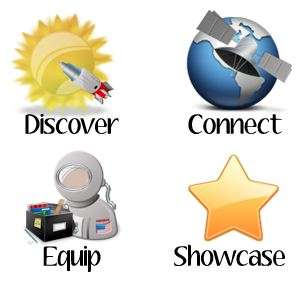NASA INSPIRE

INSPIRE
NASA INSPIRE (Interdisciplinary National Science Project Incorporating Research and Education Experience) was a NASA educational program operated 2009-2013 as a year-round project designed for students in ninth to 12th grade who are interested in science, technology, engineering and mathematics (STEM), topics and careers.[1] The program has been terminated and no longer exists.
Students participated in INSPIRE largely through the online learning community (OLC). Students met eligibility standards to apply to program. Those who were accepted had the opportunity to participate in a wide variety of activities, projects and challenges, some of which were on their own and some of which were undertaken collaboratively with other INSPIRE students and/or NASA personnel. INSPIRE was one of NASA's educational outreach programs with 305 active students in the 2012-2013 school year and had been referred to as a "great way to get high-school age students involved in science, technology, engineering, and math" by NASA officials.[2] Students accepted to the program were offered several opportunities annually to participate in group research and design project competitions. There was a space habitat competition annually. The best submissions in these contests were generally reviewed by NASA scientists.
Online Learning Community
Students were required to apply, or reapply if they are recurring participants, to the INSPIRE program in late March–June. The requirements a student must meet in order to be eligible to apply were at (NASA INSPIRE website):
- Be entering the ninth through 12th grade when the school year begins.
- Be at least 13 years of age or older at the time of application.
- Be a U.S. citizen.
- Have a minimum of a 2.5 academic grade point average on an unweighted 4.0 scale.
- Demonstrate the desire and the academic preparation to pursue a STEM-related field of study beyond high school.
- Complete the online application process, including all three essays, with all required documentation.
The required documentation included a school transcript, listing of all STEM courses taken in high-school thus-far, extra-curricular activities, etc. The applicant also completed three essays, and signed and mailed an application certification.
Once accepted, the student participant had the opportunity in the Online Learning Community (using a log in provided by the INSPIRE program and starting at this log in page: http://nasaoc.okstate.edu/). In this Online Community, students discussed STEM topics with other participants, INSPIRE alumnae who were in college, and NASA personnel, participatef in weekly group chats with NASA scientists and engineers, and earnrf points for completing individual and group STEM activities that range from calculations of trajectories to designing a potential lunar habitat.[3] Once completef, the group activities such as the habitat competition were sometimes reviewed and commented upon by NASA personnel.[4] The INSPIRE points were a factor in selections for additional activities associated with INSPIRE. Points were also a factor in determining eligibility of the participants to apply from within the INSPIRE program for exclusive summer opportunities. These summer opportunities varied in scope depending on available funding from year to year. In the first few years of the INSPIRE program, selected participants were chosen to spend up to a week immersed in STEM learning at universities and NASA facilities. In later years, the summer opportunities for selected participants ranged from virtual experiences through the INSPIRE online system to a multi-day program at Kennedy Space Center.[5]
INSPIRE OLC Components
- Latest News
- Monthly Themes
- Weekly Polls
- LiveChats
- Activities
- Featured NASA Center
- Fact of the Day
- eINSPIRE Archive
- Discussion Boards
- Leader Board
- Forums

Download the INSPIRE Brochure [912KB PDF file]
NASA Centers
| NASA Center | Location | Area of Service |
|---|---|---|
| NASA Facility: Ames Research Center | Moffett Field, California | Alaska, Northern California (southernmost counties of Inyo, Kings, Monterey, Tulare), Hawaii, Idaho, Montana, Nevada, Oregon, Utah, Washington, Wyoming |
| Neil A. Armstrong Flight Research Center | Edwards Air Force Base, California | Arizona, Southern California (northernmost counties of Kern, San Bernardino, San Luis Obispo) |
| Glenn Research Center | Cleveland, Ohio | Illinois, Indiana, Michigan, Minnesota, Ohio, Wisconsin |
| Goddard Space Flight Center | Greenbelt, Maryland | Connecticut, Delaware, District of Columbia, Maine, Maryland, Massachusetts, New Hampshire, New Jersey, New York, Pennsylvania, Rhode Island, Vermont |
| Jet Propulsion Laboratory | Pasadena, California | TBD |
| Johnson Space Center | Houston, Texas | Colorado, Kansas, Nebraska, New Mexico, North Dakota, Oklahoma, South Dakota, Texas |
| Kennedy Space Center | Merritt Island, Florida | Florida, Georgia, Puerto Rico, U.S. Virgin Islands |
| Langley Research Center | Hampton, Virginia | Kentucky, North Carolina, South Carolina, Virginia, West Virginia |
| Marshall Space Flight Center | Huntsville, Alabama | Alabama, Arkansas, Iowa, Missouri, Tennessee, Louisiana |
| Stennis Space Center | near Biloxi, Mississippi | Mississippi, Louisiana |